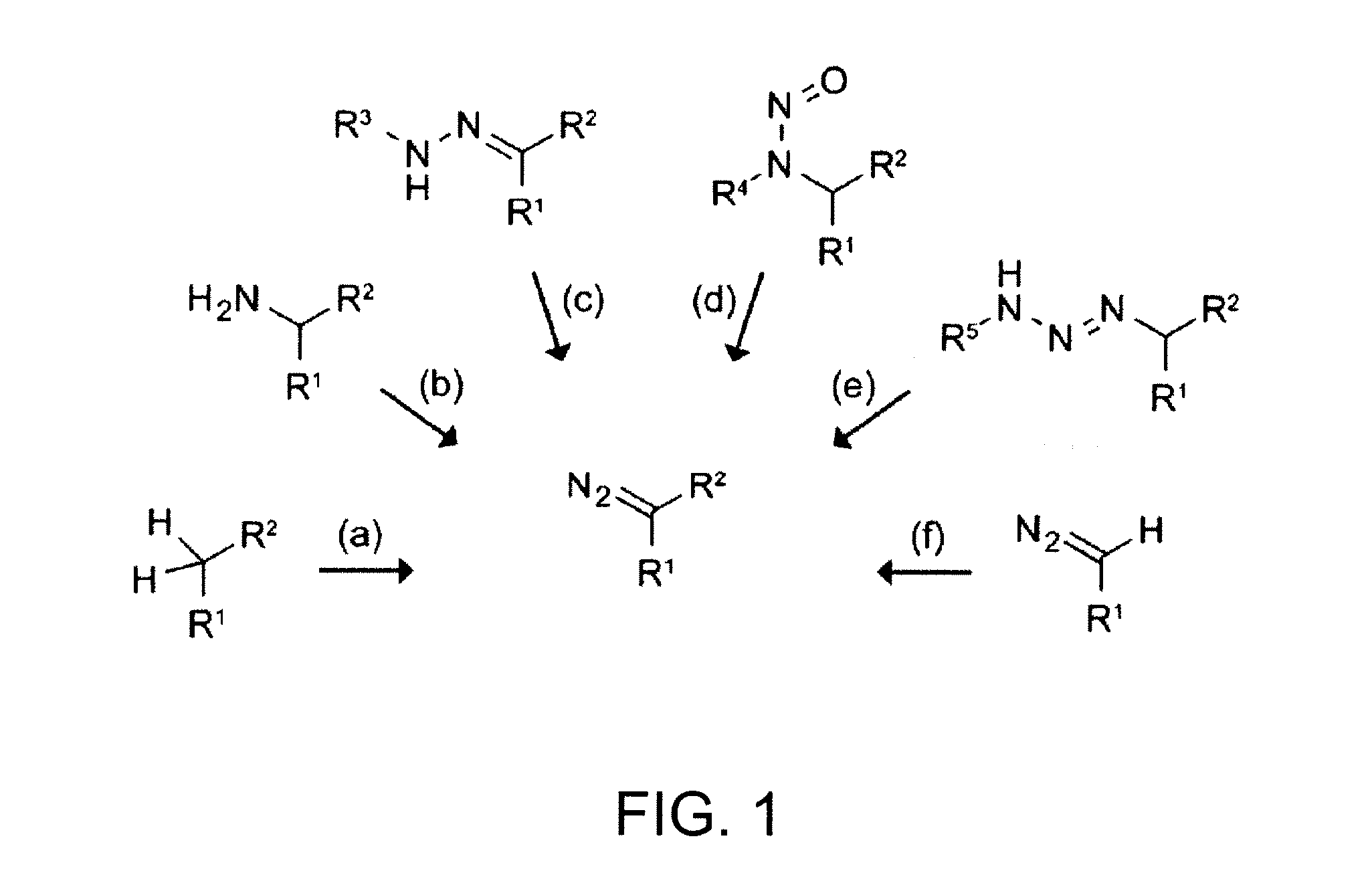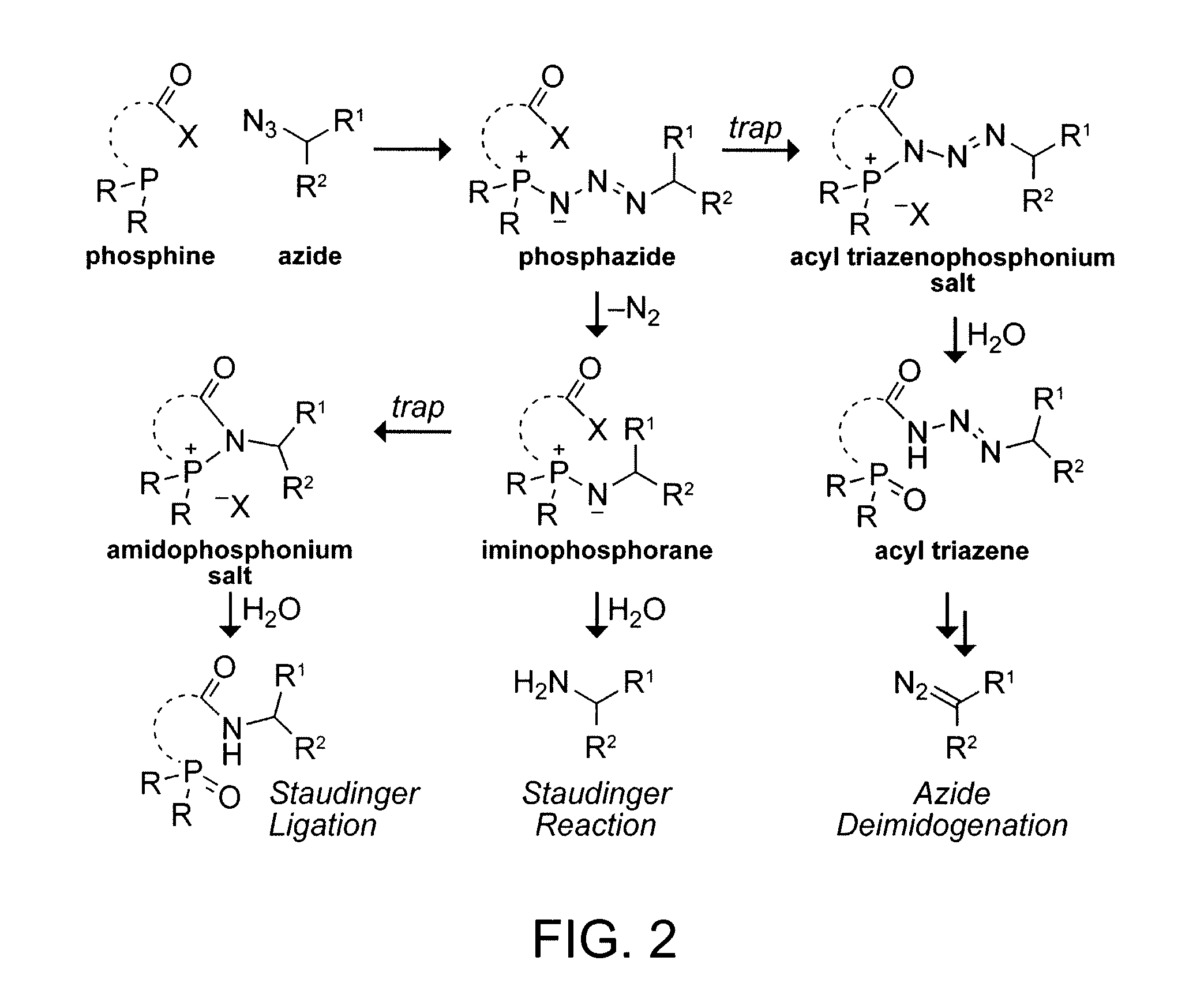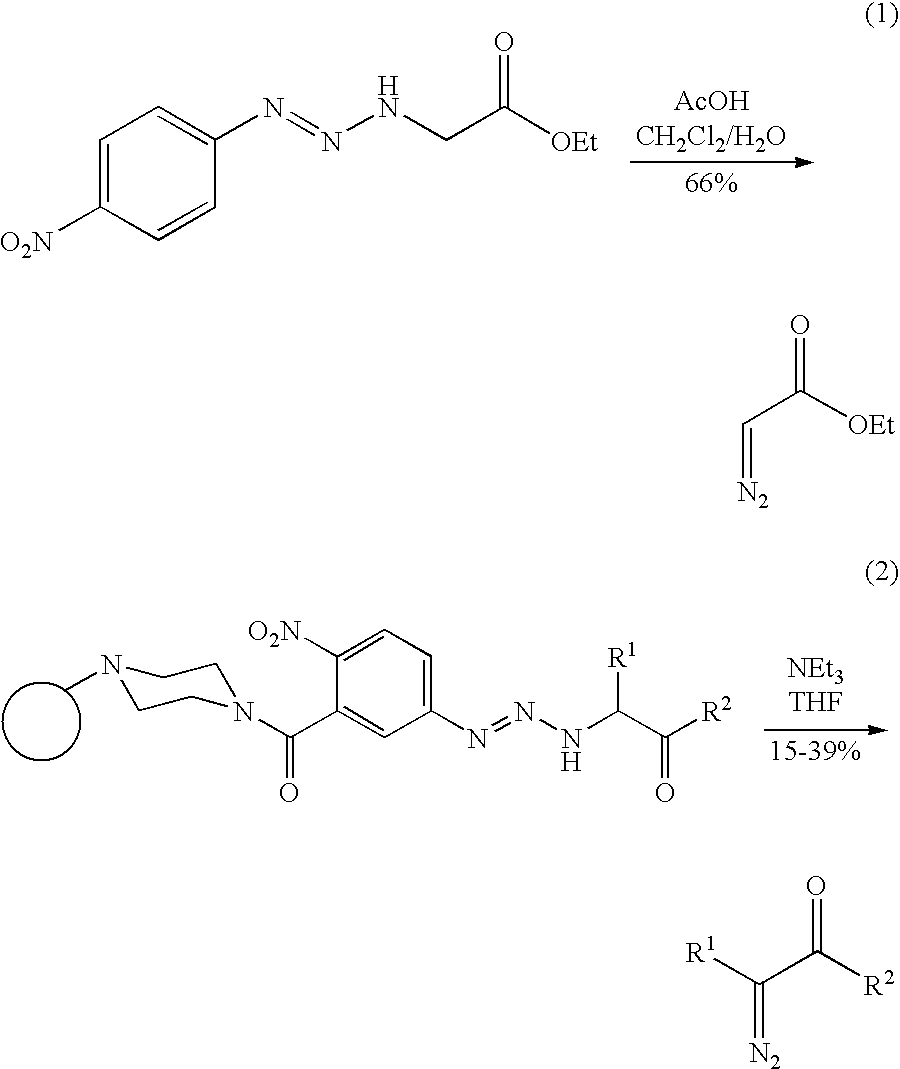Preparation of diazo and diazonium compounds
a technology which is applied in the field of preparation of diazo and diazonium compounds, can solve the problems of limited synthetic utility of methods and the challenge of diazo-compound preparation and isolation
- Summary
- Abstract
- Description
- Claims
- Application Information
AI Technical Summary
Benefits of technology
Problems solved by technology
Method used
Image
Examples
example 1
General Methods
[0248]Reagent chemicals were obtained from commercial suppliers, and reagent grade solvents were used without further purification. Anhydrous CH2Cl2 was obtained from a CYCLE-TAINER® solvent delivery system (Baker). Anhydrous Toluene and CH3CN were obtained from Sigma-Aldrich. Procedures were performed at room temperature (˜23° C.) unless indicated otherwise. Reactions were monitored by thin-layer chromatography using Whatman® aluminum-backed silica gel TLC plates with visualization by UV light. Compounds were purified by flash chromatography on silica gel, which had a mesh of 230-400 (ASTM) and a pore size of 60 Å or on basic aluminum oxide (Brockmann Grade V), which had an approximate mesh of 150 and a pore size of 58 Å. The removal of solvents and other volatile materials “under reduced pressure” refers to the use of a rotary evaporator at water-aspirator pressure (<20 torr) and a water bath of <40° C.
[0249]NMR spectra were acquired at ambient temper...
example 2
Synthesis of Phosphines
Ethyl 2-(diphenylphosphanyl)benzoate (1a)
[0250]
2-(Diphenylphosphanyl)benzoic acid (0.50 g, 1.63 mmol) and 4-dimethylaminopyridine (DMAP, 20 mg, 0.163 mmol) were dissolved in CH2Cl2 (10 mL). Ethanol (0.29 mL, 4.89 mmol) was added, and the solution was placed under Ar(g) and cooled to 0° C. N,N′-Diisopropylcarbodiimide (DIC, 0.25 mL, 1.63 mmol) was added dropwise, and the resulting solution was allowed to warm to room temperature and stirred overnight. The solution was then filtered, and the filtrate was concentrated under reduced pressure. The resulting residue was purified by silica gel column chromatography, eluting with 10% EtOAc(ethylacetate) / hexanes, to give phosphine 1a as a pale yellow solid (0.44 g, 1.32 mmol, 81% yield). 2-(Diphenylphosphanyl)benzoic acid was purchased from Sigma-Aldrich (St. Louis, Mo.).
[0251]Data for 1a: 1H NMR (400 MHz, CDCl3) δ=8.07 (m, 1H, Ar.), 7.44-7.25 (m, 12H, Ar.), 6.93 (m, 1H, Ar.), 4.22 (q, 2H, J=7.1 Hz, OCH2CH3), 1.21 (t, ...
example 3
Synthesis of Azides
2-Azido-N-benzyl-3-phenylpropanamide (2b)
[0260]
2-Azido-3-phenylpropanoic acid (J. T. Lundquist IV, J. C. Pelletier, Org. Lett. 2001, 3, 781-783) (112 mg, 0.588 mmol) and HOBt (108 mg, 0.705 mmol) were suspended in CH2Cl2 (2 mL), and the mixture was cooled to 0° C. under Ar(g). DIC (107 μL, 0.705 mmol) was added, and the resulting mixture was stirred for 30 min. Benzyl amine (122 μL, 1.06 mmol) was then added, and the mixture was allowed to warm to room temperature and then stirred overnight under Ar(g). The mixture was filtered, and the solvent was removed under reduced pressure. The residue was purified by silica gel flash chromatography, eluting with 15% EtOAc / hexanes, to give the required amide 2b as a white solid (117 mg, 0.418 mmol, 71% yield).
[0261]Data for 2b: 1H NMR (400 MHz, CDCl3) δ=7.35-7.21 (m, 7H, Ar.), 7.16-7.10 (m, 3H, Ar.), 6.52 (br. s, 1H, NH), 4.43 (dd, 1H, J=14.7, 6.1 Hz, NHCH2Ph), 4.37 (dd, 1H, J=14.7, 5.4 Hz, NHCH2Ph), 4.24 (dd, 1H, J=7.7, 4.0...
PUM
| Property | Measurement | Unit |
|---|---|---|
| temperature | aaaaa | aaaaa |
| temperature | aaaaa | aaaaa |
| pH | aaaaa | aaaaa |
Abstract
Description
Claims
Application Information
 Login to View More
Login to View More - Generate Ideas
- Intellectual Property
- Life Sciences
- Materials
- Tech Scout
- Unparalleled Data Quality
- Higher Quality Content
- 60% Fewer Hallucinations
Browse by: Latest US Patents, China's latest patents, Technical Efficacy Thesaurus, Application Domain, Technology Topic, Popular Technical Reports.
© 2025 PatSnap. All rights reserved.Legal|Privacy policy|Modern Slavery Act Transparency Statement|Sitemap|About US| Contact US: help@patsnap.com



